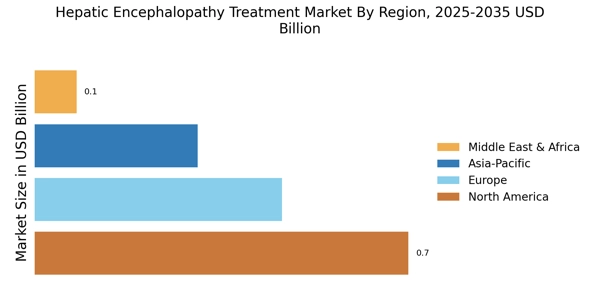Growing Awareness and Education
There is a marked increase in awareness and education regarding hepatic encephalopathy, which is positively impacting the Hepatic Encephalopathy Treatment Market. Healthcare professionals and patients are becoming more informed about the condition, its symptoms, and the importance of timely intervention. This heightened awareness is likely to lead to earlier diagnosis and treatment, ultimately improving patient outcomes. Educational initiatives and campaigns are being implemented to disseminate information about hepatic encephalopathy, thereby fostering a more proactive approach to management. As awareness continues to grow, the demand for effective treatment options within the Hepatic Encephalopathy Treatment Market is expected to rise.
Aging Population and Comorbidities
The aging population is a significant factor driving the Hepatic Encephalopathy Treatment Market. As individuals age, the incidence of liver-related diseases tends to increase, often accompanied by comorbidities such as diabetes and hypertension. This demographic shift is likely to result in a higher prevalence of hepatic encephalopathy, necessitating effective treatment solutions. The World Health Organization has indicated that the global population aged 60 and above is projected to double by 2050, which may further exacerbate the burden of liver diseases. Consequently, the Hepatic Encephalopathy Treatment Market is poised for growth as healthcare systems adapt to meet the needs of this aging cohort.
Rising Incidence of Liver Diseases
The increasing prevalence of liver diseases, particularly cirrhosis and hepatitis, is a primary driver of the Hepatic Encephalopathy Treatment Market. As liver dysfunction escalates, the risk of hepatic encephalopathy rises, necessitating effective treatment options. According to recent data, liver diseases affect millions, with a notable rise in cases attributed to lifestyle factors such as alcohol consumption and obesity. This trend underscores the urgent need for innovative therapies and management strategies within the Hepatic Encephalopathy Treatment Market. The growing patient population is likely to stimulate demand for both established and novel treatment modalities, thereby propelling market growth.
Advancements in Treatment Modalities
Innovations in treatment modalities are significantly influencing the Hepatic Encephalopathy Treatment Market. The introduction of new pharmacological agents, such as rifaximin and lactulose, has transformed the management of hepatic encephalopathy, offering improved efficacy and safety profiles. Furthermore, ongoing clinical trials are exploring additional therapeutic options, which may enhance patient outcomes. The market is projected to expand as healthcare providers increasingly adopt these advanced treatments, driven by the need for effective management of hepatic encephalopathy. This evolution in treatment strategies is expected to attract investment and research, further enriching the Hepatic Encephalopathy Treatment Market.
Regulatory Support and Funding Initiatives
Regulatory support and funding initiatives are playing a crucial role in shaping the Hepatic Encephalopathy Treatment Market. Governments and health organizations are increasingly recognizing the need for effective treatments for hepatic encephalopathy, leading to enhanced funding for research and development. Initiatives aimed at improving healthcare access and affordability are likely to facilitate the introduction of new therapies into the market. Additionally, favorable regulatory frameworks may expedite the approval process for innovative treatments, thereby encouraging pharmaceutical companies to invest in the Hepatic Encephalopathy Treatment Market. This supportive environment is expected to foster growth and innovation in the sector.


















Leave a Comment